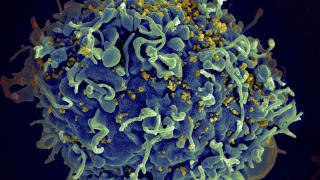The man had been living with HIV for 31 years before coming to City of Hope with another grave diagnosis — acute myeloid leukemia. One of the best hopes for long-term remission of acute myeloid leukemia (AML) is a stem cell transplant, and City of Hope has one of the nation’s leading transplant programs, having performed more than 17,000 transplants since 1976. In addition, the institution is at the forefront of using transplants to treat older adults with blood cancers, including increasing efficacy and safety in those over 60 and those with comorbidities, like the then 63-year-old City of Hope patient with HIV. The research was presented by Jana K. Dickter, M.D., City of Hope associate clinical professor in the Division of Infectious Diseases.
City of Hope hematologist Ahmed Aribi, M.D., assistant professor in the Division of Leukemia, prepared the patient for an allogeneic blood stem cell transplant with a chemotherapy-based, reduced-intensity regimen developed for treatment of older patients with blood cancers. Reduced-intensity chemotherapy makes the transplant more tolerable for older patients and reduces the potential for transplant-related complications from the procedure.
Aribi and his team worked with City of Hope’s Unrelated Donor BMT Program — directed by Monzr M. Al Malki, M.D. — to find a donor who was a perfect match for the patient and had the rare genetic mutation, homozygous CCR5 Delta 32, which is found in just 1 to 2% of the general population.
People who have this mutation have a resistance to acquiring HIV. CCR5 is a receptor on CD4+ immune cells, and most strains of HIV use that receptor to enter and attack the immune system. But the CCR5 mutation blocks that pathway, which stops HIV from replicating.
After this successful transplant for both AML and HIV, the patient has been in remission for HIV since stopping ART in March 2021. While this outcome has happened in three other patients, the City of Hope patient was both the oldest to undergo a transplant with HIV and leukemia and go into remission for both. He had also lived with HIV the longest — 31 years.
“The City of Hope patient is another major advancement. It demonstrates that research and clinical care developed and led at City of Hope are changing the meaning of an HIV diagnosis for patients across the United States and the world,” said John Zaia, M.D., director of City of Hope’s Center for Gene Therapy, Aaron D. Miller and Edith Miller Chair for Gene Therapy and a leader in HIV research. “City of Hope remains at the forefront of clinical research that changes people’s lives for the better.”
“When I was diagnosed with HIV in 1988, like many others, I thought it was a death sentence. I never thought I would live to see the day that I no longer have HIV. City of Hope made that possible, and I am beyond grateful.” — The City of Hope patient
Building on Past Success to Better Treat HIV
The story above is one significant example of several important advances being made at City of Hope in the care of people with HIV. When many centers still treated patients with low-intensity, noncurative treatment approaches for HIV-related lymphoma, City of Hope challenged that paradigm by demonstrating that autologous transplantation could be used to cure patients who would otherwise die.
More recently, City of Hope is leveraging its leadership in CAR T cell therapy — a groundbreaking treatment currently used to rally the body’s natural defenses against cancer — and exploring its potential in tandem with another advance, City of Hope’s vaccine for cytomegalovirus (CMV).
In a proof-of-concept study, funded by the California Institute for Regenerative Medicine, lab models demonstrated that the combination therapy could recognize and eliminate HIV without serious toxicity to cells in the virus’ host. In cultured human cells, the CAR T cells killed cells tagged with the gp120 protein, and kept killing them, without significant signs of risking damage to healthy cells. In a mouse model for HIV/AIDS, high doses of the dual-action CAR T cells followed by the CMV vaccine were successful in controlling HIV, and even nestled into the bone marrow, indicating potential for treatment to keep working over the long term.
City of Hope Named Among Top 10 Hospitals for Cancer in U.S.
In addition to achieving breakthrough outcomes in cancer and HIV, City of Hope has been recognized as the seventh "Best Hospital" for cancer in the nation according to U.S. News & World Report's 2022-23 Best Hospitals: Specialty Ranking. This marks the first time the cancer treatment center has cracked the top 10 of the U.S. News & World Report annual rankings and the 16th consecutive year it has been distinguished as one of the nation's elite cancer hospitals. It was also rated as high performing in four cancer surgery specialties: lung, colon, prostate and ovarian cancers.
Refer a Patient
To refer a patient, visit CityofHope.org/refer-a-patient, or call 800-264-4377 to speak with a patient referral specialist.
To enroll a patient to a clinical trial, please call 626-218-1133 or visit CityofHope.org/research/find-a-clinical-trial for additional information about clinical trials at City of Hope.
